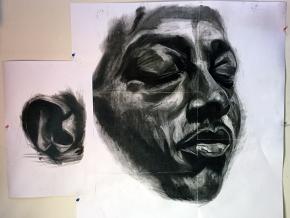Mapping our morbid symptoms
reviews Morbid Symptoms, a recent show by artist Sarah Levy that shows the connections between those suffering and struggling in the U.S. and Middle East.
THE SIX-foot-tall, anguished face of a Kalief Browder looms in the center of a large white wall. He is drawn in charcoal and isolated in a sea of white. His face is tilted upward and his closed eyes seem to be holding back unspeakable, seeping and unending grief.
This face, titled "Kalief Browder (Rikers Island)," was the centerpiece for artist Sarah Levy's show, Morbid Symptoms, which ran from January 10-30 at the White Gallery at Portland State University (PSU).
The show featured 12 portraits, drawn from photographs of people in the United States and the Middle East during pivotal moments of struggle. The title of the show is a reference a phrase that appears in Antonio Gramsci's Prison Notebooks. Gramsci observes, "The crisis consists precisely in the fact that the old is dying and the new cannot be born; in this interregnum a great variety of morbid symptoms appear."
Levy, a long-time activist and organizer, wanted to shine light on the morbid symptoms of the current moment. Her artist statement explains: "Gramsci's statement feels particularly apt to the United States of America in light of Donald Trump's election. Many people today feel disoriented, grieving a past America or a past notion of what that America was, as well as rightful fear of what is to come."

Levy elaborated in an interview on what she saw as the purpose of the show and the connection to the Gramsci quote:
I think there is hope in the notion of something new struggling to be born...I wanted to recognize the grief and horror that some people were feeling right when Trump was elected, and in a way, get folks to step back and see the current moment in the U.S. as part of a broader moment. This is where the Gramsci quote comes in...
[T]here will be horror and there will be incredibly beautiful moments (both of which we've seen already since his inauguration), but that we have to have the underlying understanding that both come from the need for a new world to be born.
THE SETUP of the White Gallery, which is located in a large hallway in the midst of the busy student union of PSU, allowed Levy to emphasize the connection to the broader moment. One wall contained drawings representing the struggles in the Middle East (Syria, Egypt and Palestine) and, on the opposite wall, struggles in the United States (Ferguson, Missouri; Baltimore; the Rikers Island jail complex in New York City; Flint, Michigan; and Standing Rock, North Dakota).
While walking through the hallway, the audience was compelled to study the 12 large charcoal faces. All of the portraits, with the exception of the one of Browder, were 2 feet by 3 feet. The only color in the show came from the piercing blue eyes of a little girl from Syria, who stares straight ahead, with a tear streaming down her cheek.
With titles like "Egypt 2013 (grief)," "Egypt 2013, 4 (protest)," and "Gaza 4 (lost child, July 2014)," Levy wanted to "give enough detail to help the viewer understand the context and the piece, but also to let them fill in the story, or look into it."
As the viewer connects with the face in front of them, they also question the lives and circumstance of the subject--people who have been ignored or misrepresented by the media. In Levy's show, they were given the spotlight and their faces told a raw and unedited story. Their portraits were drawn with the care that has been historically reserved for people with wealth and status. Levy observed:
If you look at a lot of classical art, the paintings that are held up are mostly of rich white men (as well as of their mistresses). To have your portrait painted meant that you...deserved attention and respect [and] deserved to be remembered. Through my portraits I want to flip that. I want to show you the people who I think matter, who you might not already know about.
In particular, the towering face of Kalief Browder draws considerable attention to the young man who destroyed by the criminal injustice system. Browder was 16 years old when he was arrested on suspicion of stealing a backpack. He was sent to Rikers and imprisoned for three years before his case was finally dismissed. During that time, he was beaten by guards and inmates and spent a total of 800 days in solitary confinement. After experiencing such intense helplessness and isolation, Browder took his own life at the age of 22.
That isolation is evident in Levy's drawing, but in taking a step back, the viewer sees Browder is not alone. The walls are lined with faces of people who are suffering--and the viewer recognizes their own pain in those faces. As Levy says in the artist statement, "There can be pain, connection and also relief in seeing your own intense feelings reflected back to you in the face of another."
Socialists know that solidarity is essential to our liberation. It is only in seeing that our suffering and struggling is linked with the suffering and struggles of others that we will be able to stand together and demand an end to capitalism, the common denominator in theses international struggles.
Levy noted the connective power of art by quoting David Foster Wallace: "We all suffer alone in the real world...But if a piece of [art] can allow us imaginatively to identify with a character's pain, we might then also more easily conceive of others identifying with our own. This is nourishing, redemptive; we become less alone inside."
"To me," Levy added, "that gives us more power to rise up and fight."


